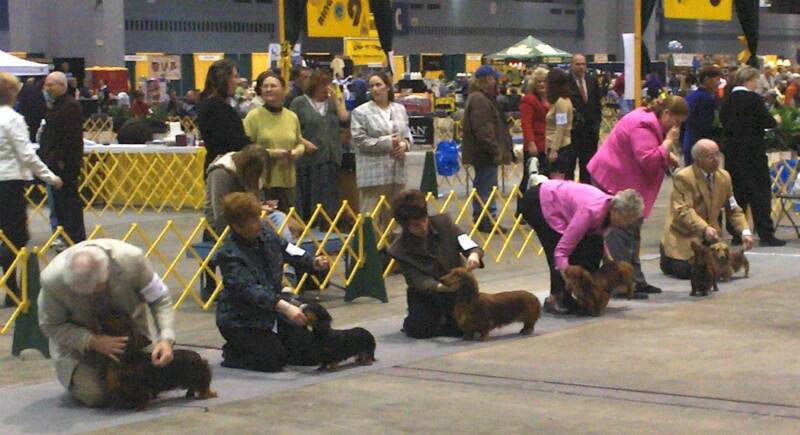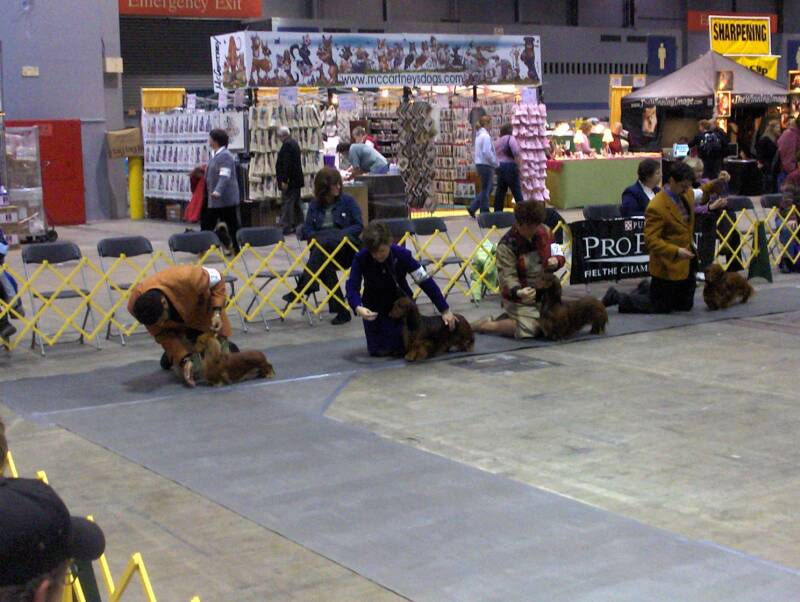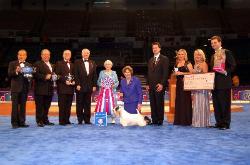UNDERSTANDING DOG SHOWS – AKC CONFORMATION
The American Kennel Club (AKC) is the primary canine registry in the United States. One of the many advantages of registering your purebred Dachshund with the AKC is the ability to compete in a variety of AKC sanctioned events with your dog. This page describes one of the most popular AKC events known as “Conformation”. Conformation refers to the type of competition that occurs at dog shows throughout the country. Many of these events are nationally televised, such as the Westminster Kennel Club Show and the AKC Eukeneuba National Championship. Though these are two of the most well known dog shows, conformation events are occurring all over the country throughout the year. Chances are there are at least a few dog shows each year within driving distance of wherever you live. If you enjoy watching dog shows on television, you will likely find attending one in person even more exciting. The AKC currently recognizes over 160 different breeds of dogs, from the Affenpinscher to the Yorkshire Terrier, and dog shows provide a great opportunity to see the best of these breeds on display.
The purpose of a dog show is to judge to what degree each dog being shown “conforms” to the official standard set for the breed. The standard for Dachshunds, as with other breeds, describes the idea appearance, features and descriptions determined to be ideal for a Dachshund. The standards are typically set by a breed’s “parent club”, in the Dachshund breed, the parent club is the Dachshund Club of America. Parent clubs are made up of members who breed and show dogs of the particular breed. Dachshunds come in three “Varieties” – “Long Haired”, “Smooth”, and “Wire Haired”. The standard is the same for all three varieties, except for the coat, which is different for each.
At a dog show, all dogs of a particular breed are competing with one another to determine which of them most closely conforms to the standard for that breed. The dog selected for this honor is designated “Best of Breed”, and moves on to compete against dogs of other breeds, but is always judged by the degree to which the dog conforms to the standard for its breed. Only unaltered dogs are eligible for competition in AKC conformation events. As the purpose of dog shows is to exhibit breeding stock, any dog that has been spayed or neutered cannot be bred, thus is ineligible to participate. The rules and procedures involved in dog shows are somewhat intricate, but can be easily understood if broken down and examined in detail.
Starting at the Beginning
You’ve purchased a new puppy, registered it with the AKC and are excited about the prospect of exhibiting your dog at dog shows in your area. The first milestone to work towards in this process is achieving Championship status for your dog. The title of AKC Champion in conformation is designated by the initials “Ch” in front of the dog’s registered name. You may also hear the term “finished” to refer to a dog that has met the requirements for his AKC Championship. Most of the dogs you see on televised dog shows have this designation. Whether or not you choose to show your dog (referred to as “handling”) yourself or engage the services of a professional handler, the mechanics of becoming a champion remain the same.
Becoming a Champion – The Road to Glory Begins
In AKC conformation events, your dog must be at least six months old in order to compete. All of the dogs of a particular breed will compete in the same show ring and be evaluated by the same judge. The dog’s gender, age and breeding designation are three factors that determine how your dog will be entered in the competition. Male dogs are referred to simply as ‘dogs’, while the females of all breeds are referred to as ‘bitches.’ Prior to determining which dog is selected as “Best of Breed”, a series of preliminary competitions occur to narrow down the competitive field. This begins with all dogs that have not yet achieved their AKC championship competing against each other for the points that they must accrue to earn this title. In order to become an AKC champion, a dog must accrue at least 15 championship points. We’ll discuss championship points in more detail in just a bit.
The males (dogs) who have not yet earned their championship compete against each other in various groupings or ‘classes’ (similar to heats in a track meet) to determine which dog most closely conforms to the breed standard. This dog is awarded the honor of being chosen “Winner’s Dog”. The bitches then compete against each other in different classes for the honor of “Winner’s Bitch”. The dogs or bitches in a particular class compete against each other and are awarded ribbons for first, second, third and fourth place. The first place winners from each class then compete for Winner’s Dog and Winner’s Bitch.
Classes: In AKC conformation events, the following classes are typically offered. An exhibitor (the person showing the dog) selects which preliminary class they wish to show their dogs in. The classes are the same for both dogs and bitches, and typically follow this order:
Puppy dog (or bitch) 6 – 9 months – this class is for dogs that are at least six months old at the date of the show but are no more than nine months old.
Puppy dog (or bitch) 9 – 12 months - this class is for dogs that are at least nine months old at the date of the show but are no more than twelve months old. Depending on the number of entries in a particular show, these two classes may be combined to include all puppies between the ages of six and twelve months.
Twelve to Eighteen Month Dogs (or Bitches) - this class is limited to dogs that are at least twelve months old at the date of the show but are no more than eighteen months old.
Bred-By-Exhibitor Dogs (or Bitches) – this class is open to dogs or bitches that are at least six months of age and have been bred by the individual showing the dog. As most professional handlers do not breed the dogs they show, this is often a popular class where breeders can directly exhibit their breeding stock. Age is not a restriction in this class, as long as the puppy is at least six months old.
American Bred Dogs (or Bitches) – this class is open only to any dog or bitch bred in the United States.
Open Dog (or Bitch) – this category is open to any AKC eligible dog or bitch. In the Dachshund breed, this class is offered twice – once for open miniature dogs or bitches, and once for open standard dogs or bitches. In the United States, miniature and standard sized Dachshunds compete as one breed, unlike in Canada, where they compete as two separate breeds. This is the only class distinction for miniature and standard Dachshunds. In all of the other classes listed above, miniatures and standards compete together.
Points: As we mentioned earlier, after all of the classes have been shown for dogs, the winner of each class comes back into the ring to compete for Winner’s Dog. This competition happens before any of the bitch classes are shown. The judge chooses the dog from among the class winners that he or she feels most closely resembles the ideal dog according to the breed standard. This dog is selected as Winner’s Dog, and is the only male dog who earns points for that show. After the Winner’s Dog is selected, the dog who finished second to the Winner’s Dog in that class reenters the ring and is eligible to compete against the other class winners for “Reserve Winner’s Dog”. This runner up designation is important, in that should the Winner’s Dog later be deemed ineligible for some reason, the Reserve Winner’s Dog would then receive the Winner’s Dog points. This process is repeated for the bitches after all the bitch classes have been shown.
The number of points earned by the Winner’s Dog and Winner’s Bitch is determined by the number of entries, and the region of the country where the show occurs. The available points are calculated separately for dogs and bitches, and is based on the typical number of dogs or bitches both registered with the AKC and entering conformation events for the particular region of the country. Between one and five points are awarded based on these criteria. Typically, breeds that are more commonly shown in a particular region require more entered dogs or bitches for the Winner’s Dog or Bitch to be awarded more points. This makes sense, given that the purpose of the dog show is to find the best examples of the breed at that time. There is some potential for crossover in awarding points to Winner’s Dog and Winner’s Bitch. If there are enough bitches to merit the win being a major (3, 4 or 5 points) but not enough dogs entered to merit a major win
(1 or 2 points), the Winner’s Dog can still earn a major win. This happens only if the judge feels that the Winner’s Dog is a better example of the breed standard than the Winner’s Bitch. If so, the Winner’s Dog is designated “Best of Winners” and receives the same number of points received by the Winner’s Bitch.
If enough dogs or bitches are entered in a dog show so that at least 3 points are scheduled to be awarded the Winner’s Dog and Winner’s Bitch, this win is referred to as a “major”, and is important in calculating points towards an AKC championship. In order to earn the title of AKC Champion in conformation, a dog or bitch must accrue 15 points. These 15 points must include at least two major wins (3, 4 or 5 points). The two major wins must occur under two different judges, to ensure a fair and objective assessment of the dog or bitch’s conformation.
Best in Show
The ultimate goal for any conformation event is to select the best dog entered among all breeds. This dog is then designated as “Best in Show”, and receives all the glory, and typically a cash or other significant prize. Let’s take a look at how this works. All dogs or bitches selected as Best of Breed now move on to compete against dogs of other breeds from among their designated “group.” There are seven group classifications of the 157 breeds recognized by the AKC. Groups are comprised of dogs bred for similar functions. The seven AKC breed groups are the Hound Group (which includes Dachshunds, Beagles, Bloodhounds, Afghan Hounds, etc.); the Working Group (Doberman Pinschers, Rottweillers, Grate Danes, etc.); the Herding Group (German Shepherds, Collies, Pembroke Welsh Corgis, etc.), the Sporting Group (Labrador Retriever, Cocker Spaniel, Irish Setter, etc.); the Non-Sporting Group (Bulldog, Dalmation, Poodle); the Terrier Group (Aerdale Terrier, Jack Russell Terrier, Irish Terrier, etc.); and the Toy Group (Shih-Tzu, Pomeranian, Yorkshire Terrier, etc.).
Best of Breed Competition
This occurs after the Winner’s Dog and Winner’s Bitch are selected. Both the Winner’s Dog and Winner’s Bitch are eligible to compete for Best of Breed, and it is at this point in the competition that other dogs or bitches who have previously earned their AKC Champion title enter the ring to compete. Dogs and bitches competing in conformation events that are already champions are often referred to as “Specials.” The judge evaluates the Winner’s Dog, Winner’s Bitch, and all specials (both males and female specials compete together now) to determine which of these is selected as Best of Breed. At this point, the judge also compares the Winner’s Dog and Winner’s Bitch and determines which is Best of Winners. Another award determined at this stage include “Best of Opposite Sex” to Best of Breed. If a male dog is awarded Best of Breed, the judge selects the best female left in the ring as Best of Opposite Sex. In larger or more prestigious shows, judges may give out an “Award of Merit” to any other dog competing that they felt was exceptional.
One dog is selected as the winner of each of the seven groups, though awards are given in each group for first, second, third and fourth place. These seven dogs who have won their group then compete for Best in Show. At both the group and the Best in Show level, the dogs are being judged not against each other, but against the standard for their particular breed.
THE BIG LEAGUES – National Breed Rankings
Although the initial goal in conformation is an AKC Championship for your dog, the possibilities don’t end there. Although it is possible for an unfinished (non-Champion) dog to be named Best of Breed, this doesn’t happen often. Winning or placing in the Group (1st through 4th) is possible for a non-champion dog, but is even more rare. Some owners are satisfied with achieving Champion status for their dog and depending on the quality of the dog, ending at this point may be the best choice. None-the-less, for dogs of truly exceptional quality, presence and attitude, you may elect to continue his career beyond his Championship. The degree to which you campaign, or market such a special dog will depend on your resources, determination, and love of both the dog and of the sport of showing dogs.
There are two sets of points calculated for dogs that continue to compete past their AKC Championship. “Breed Standings” are determined by points awarded based on the number of dogs that a given dog defeats in his own breed by winning Best of Breed. In calculating breed standings, one point is given to a dog for each dog he defeats in Best of Breed competitions throughout the calendar year. “All-Breed Standings” are determined by the number of dogs defeated in all-breed competitions, including Best of Breed, Group and Best in Show wins, and Group placements.
Confused? Let’s take a fictitious dog as an example, Ch. Classic Cream Supreme, a long haired miniature Dachshund. In our example, Ch. Classic Cream Supreme is number one in Breed Standings among long haired Dachshunds, with 750 points. This means that he has defeated 750 other long haired Dachshunds in Best of Breed wins, or Best of Variety competitions at Dachshund only specialty shows. In All-Breed Standings, Ch. Classic Cream Supreme is also in first place among long haired Dachshunds, with 4205 points. This means he has defeated 4205 dogs in Best of Breed competitions (this would include the 750 Dachshunds he has defeated) and through group wins and placements, and Best in Show wins. Ch. Classic Cream Supreme’s All Breed points were accrued in the following manner:
Show #1 Hound Group1st Place
Hound Group1st Place

 210 points (meaning there were 210
210 points (meaning there were 210
Show #2 Hound Group 2nd Place
Hound Group 2nd Place 
 175 points (meaning there were 175
175 points (meaning there were 175
Show #3 Best in Show
Best in Show


 1200 points (meaning there were
1200 points (meaning there were
Show #4 Best of Variety
Best of Variety


 55 points for winning Best Long
55 points for winning Best Long
Show #5 Hound Group 3
Hound Group 3


 305 points (one for dogs in all hound
305 points (one for dogs in all hound
Show #6 Best in Show
Best in Show


 1660 points (meaning there were
1660 points (meaning there were
Total All Breed Points



 4205
4205
 | ||||||


